Fix: UEFI Firmware Settings Missing in Windows
Several Windows 10 users are reporting that they are unable to access the UEFI settings on their Windows 10 computer. In most cases, users have tried accessing the UEFI menu from the initial starting screen or via the Advanced options menu, but they weren’t able to get there. Most affected users report that the UEFI menu was accessible before.
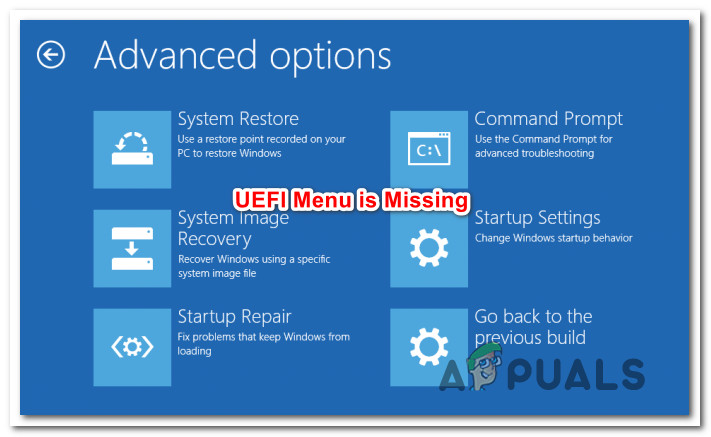
What is UEFI?
Both BIOS (Basic Input/Output System) and UEFI (Unified Extensible Firmware Interface) are low-level software menus that will start when you boot your PC (before the sequence of booting your Operating System).
But the difference between the two is, UEFI is a more modern solution – it supports graphics, mouse cursors, more security feature, faster boot times, larger hard drives and the list can go on.
There’s no way to switch to a UEFI firmware if your computer only supports BIOS. However, most new computers will include UEFI. And even more, most UEFI implementations will support backward BIOS emulation (if you’re more familiar with the old menu).
What is causing UEFI Setting to disappear from Windows 10?
We investigated this particular issue by looking at various user reports and the repair strategies that affected users have deployed in order to resolve the issue and get the UEFI Setting back. Based on what we gathered from our investigations, the are several common scenarios that will trigger this particular problem:
- Computer’s motherboard doesn’t support UEFI – Before using any of the other potential fixes, it’s important to ensure that your motherboard is equipped to support UEFI. Older computers only know how to boot into BIOS (Legacy Mode). To make sure that your computer supports UEFI, you can use the MSINFO utility.
- Fast startup function is disabling access to the UEFI menu – Fast Startup has the potential of preventing the end user from accessing the UEFI menu for the sake of shaving off an extra few seconds off the booting up time. If this scenario is applicable, you can get around this issue by either bypassing the fast startup function or by disabling it altogether.
- Extra Fast Startup is enabled – An even more aggressive function that will restrict access to the UEFI menu is the Extra Fast Startup sequence. This setting is only available with a limited number of UEFI-based motherboards, but keeping this option enabled will disable keystrokes during the boot sequence, which makes it way harder to access the UEFI firmware settings. In this case, you can reset the setting by clearing the CMOS battery.
- Windows 10 Was installed in Legacy Mode – Even if your motherboard is equipped with UEFI capabilities, your OS won’t use it if your drive is formatted with MBR instead of GPT. If this scenario is applicable, you can either use a MBR to GPT converter or install your OS again with UEFI enabled.
If you’re currently struggling to resolve this particular issue on Windows 10, this article will provide you with several troubleshooting steps. Down below, you’ll find a collection of methods that other users in a similar situation have used to resolve the problem.
For the best results, we advise you to follow the methods below in the order that they are presented in since they are ordered by efficiency and severity. As long as UEFI is supported on your system, one of the methods below is bound to resolve the issue regardless of the scenario you’re in.
Method 1: Verifying if the computer is equipped with UEFI
Before you follow other repair strategies, it’s important to be 100% sure that your computer has the necessary UEFI firmware to open the settings menu. If you’re dealing with an older computer (with an older motherboard), chances are UEFI firmware is unavailable and the only supported BIOS Mode is Legacy.
To determine if this is true or not, you can run the MSINFO utility to find out the BIOS Mode inside the System Information screen. Here’s a quick guide on how to do this:
- Press Windows key + R to open up a Run dialog box. Then, type “msinfo32” and press Enter to open up the System Information screen.
- Inside the System Information window, select System Summary from the left-hand side pane.
- Then, move over to the right pane and scroll down through the items to find BIOS Mode. If the value of BIOS Mode is UEFI, then your computer is equipped with UEFI. IF the value is Legacy, then UEFI is not supported with this particular motherboard.

Method 2: Bypassing the Fast Startup function
If Fast Startup is turned on on your Windows 10 computer, chances are every time you start your computer up after doing a regular shutdown your computer will bypass the delay in BIOS/UEFI that allows you to enter the menu.
If this is the culprit that’s stopping you from accessing your UEFI settings, one way to go around preventing this from happening is to force a normal startup that will shut down the computer to the absolute power off state.
Here’s a quick guide on how to do this:
- Click the Start icon (or press the Windows key) to access the Start menu.
- Press and hold the Shift key while clicking the Power icon and then on Shut down.

Bypassing Fast Startup - Your computer will shut down completely and fast startup will temporarily be disabled.
- Power on your computer again and start pressing the dedicated Setup key during the initial startup sequence to enter your UEFI settings.
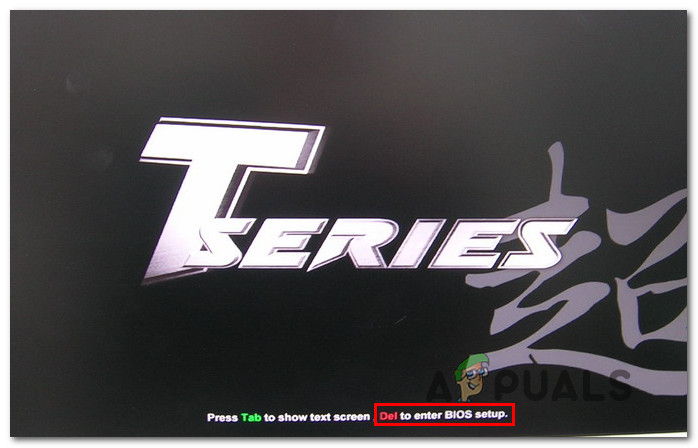
Pressing the Setup key to enter BIOS settings Note: The key should be displayed on the screen, but just in case you don’t spot it, try one of the following – Esc, Del, F2, F1, F4, F8, F10, F12. You can also search online for the specific key associated with your motherboard manufacturer.
If the issue was being caused by the Fast Startup feature, this procedure should have allowed you to access your UEFI settings.
In the event that you want to make UEFI accessible permanently or this method wasn’t applicable, move down to the next method below.
Method 3: Disabling Fast Startup
If the method above has confirmed your suspicions that Fast Startup is causing this particular issue, you can disable the feature for good to make the UEFI menu accessible at all times. But before doing this, you’ll need to know that disabling the fast startup feature will mean longer booting up times.
If you’re prepared for that, here’s what you need to do to disable fast startup:
- Press Windows key + R to open up a Run dialog box. Then, type “powercfg.cpl” and press Enter to access the Power Options menu.
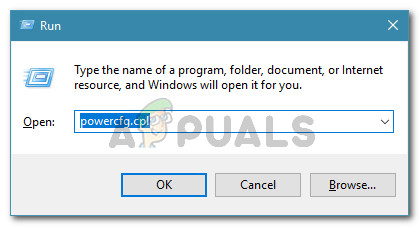
Running dialog: powercfg.cpl - Inside the Power Options menu, go over to the left-hand side menu and click on Choose what the power buttons do.

Choose what Power Buttons do – Control Panel - Inside the System Settings menu, click on Change settings that are currently unavailable. This will grant us the ability to disable the fast startup feature.
- Move down below to Shutdown settings and uncheck the box associated with Turn on fast startup.
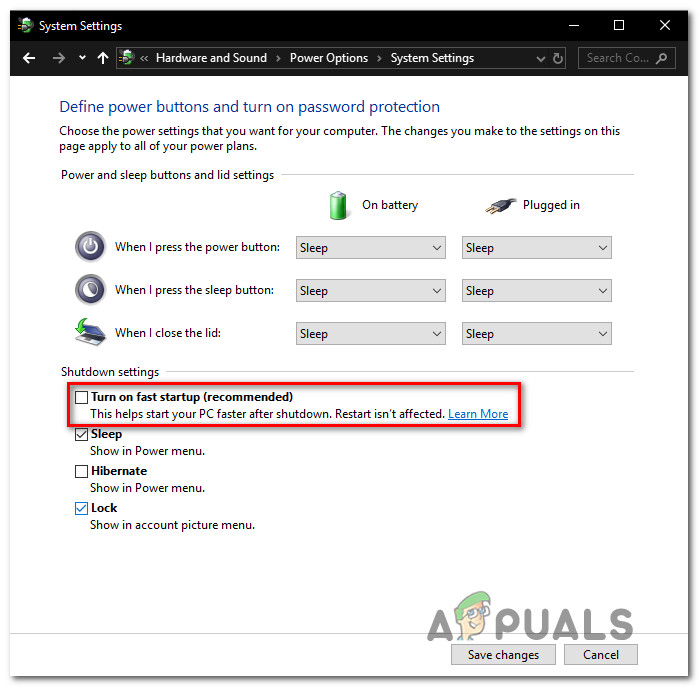
Disabling fast startup - Click on Save Changes, then shut down your computer and see if you’re able to access the UEFI settings at the next initial startup sequence.
If this method didn’t allow you to regain access into your UEFI settings, move down to the next method below.
Method 4: Clearing the CMOS (if applicable)
Another possible reason why you might be having trouble accessing your UEFI settings is due to a BIOS/UEFI feature called Extra Fast Startup. This option will shave off a couple of good seconds from the overall startup time by disabling everything that is not essential to the bootup procedure – on some computers, this option will also disable keypresses during the bootup sequence, which will effectively disable the ability to access the UEFI menu again.
If this particular scenario is applicable, you can work-around the problem by clearing the CMOS (Complementary Metal-Oxide Semiconductor) battery. Here’s a quick guide on how to do this:
Note: The steps below are only applicable to desktop PCs. Replicating this issue on a laptop is far more complicated since you’ll have to take everything apart until you reach the motherboard.
- Turn off your computer and unplug it from the power source.
- Remove the side cover and equip a static wrist band if you have one. This grounds you to the frame of the computer and evens out the electrical energy which ends up eliminating the risk of producing damage to your PC’s components.
- Take a look at your motherboard and identify the CMOS battery. Once you see it, use your fingernail or a non-conductive screwdriver to remove it from the slot.
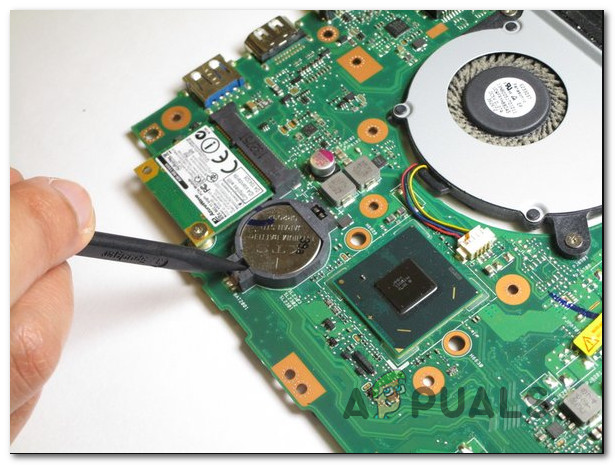
Removing the CMOS battery - Wait a couple of seconds before putting it back into place.
- Put the side cover back, plug your computer to a power source and start it up.
- The procedure that we just did ensures that every previously BIOS / UEFI setting that was saved is no forgotten. Try accessing your UEFI settings during the startup sequence and see if your keystrokes are getting registered.
If you’re still encountering the exact issue, move down to the next method below.
Method 5: Creating a Boot to UEFI Firmware Shortcut
Another way of forcing your system to boot into the UEFI Firmware settings menu is to create a shortcut capable of making your PC boot directly into that menu. Several affected users have reported that this procedure allowed them to finally access the UEFI Firmware settings menu.
Here’s a quick guide on how to do this:
- On your desktop, right-click on an empty spot and choose New > Shortcut.
- At the next screen, enter the following command and click the Next button:
shutdown /r /fw
- Name the newly created shortcut to whatever you want, then click Finish.
- Right-click on the newly created shortcut and choose Properties.
- Inside the Properties menu, go to the Shortcut tab and click the Advanced menu.
- Then, inside the Advanced Properties menu, make sure that the box associated with Run as administrator is checked. Once it is, click Ok and then Apply to save the changes.

To use the shortcut, simply double-click on it. After granting access at the UAC (User Account Control), your computer will restart directly into the UEFI settings menu.
Method 6: Reinstalling Windows 10 with UEFI enabled
If you’ve come this far without a result, chances are you didn’t install Windows 10 via UEFI. UEFI needs to be enabled when you do a clean installation of Windows 10 because it will tell your OS to use this mode instead of the legacy BIOS.
If that’s the case, one way to convince your system to use the newer UEFI menu is to use a utility capable of converting your MBR drive to GPT – you can follow this article (here) to do this.
Or, if you want to start from scratch, access your BIOS settings and make sure that the Boot Mode is set to UEFI and save the changes before you exit.
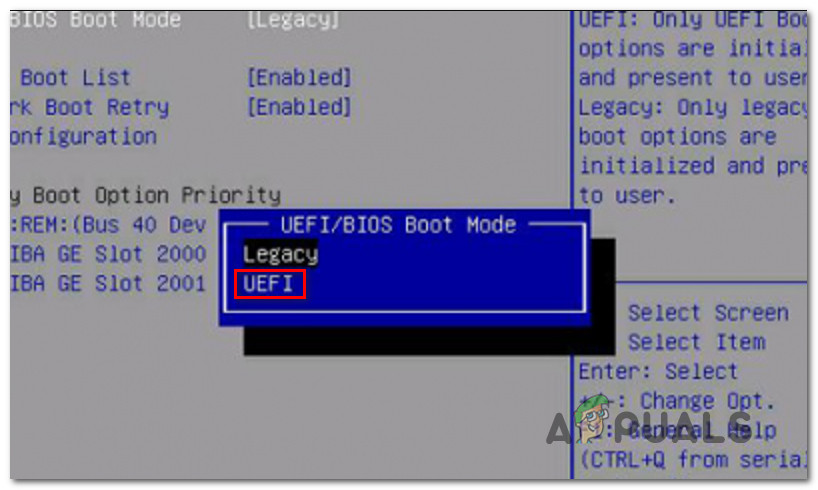
Once UEFI is enforced as the default boot mode, use this article (here) to clean install Windows 10. Once the installation is complete, your computer should be able to access the UEFI firmware settings normally.




